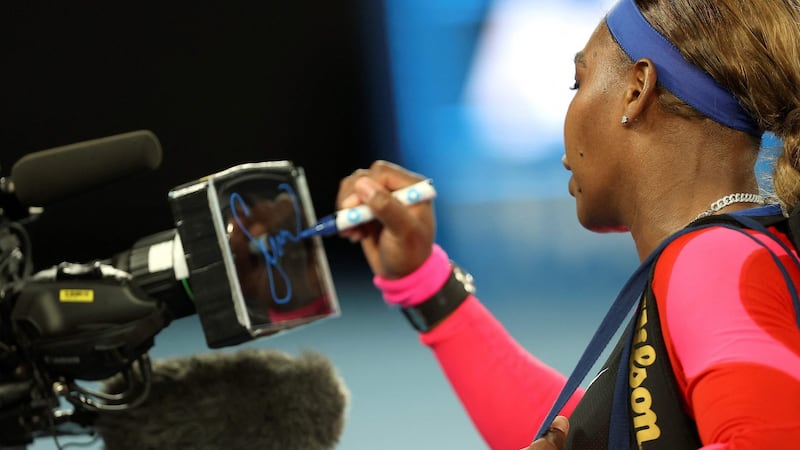Serena Williams produced a performance of the highest quality to return to the Australian Open semi-final for the first time since her last grand slam triumph there in 2017, outplaying second seed Simona Halep 6-3, 6-3. She will next face Naomi Osaka in Thursday's semi-final.
A year and a half since Halep played the match of her life on her worst surface to eviscerate Williams with the loss of just four games in the 2019 Wimbledon final, a first sign that this would not quite play out in the same manner came early on. In the first point of Halep’s opening service game, she could only watch helplessly as her 130kmh second serve exploded back across the net in the form of a 154kmh Williams forehand crosscourt return winner.
The match, however, was not only won by the quality of Williams’ ball-striking. The defining point was Williams’ movement, historically a key strength in her game that since returning to the sport after giving birth to her daughter has understandably been inconsistent. After making clear improvements in 2020, she has started the new season breezing across the court through the force of her footspeed.
In their most recent clashes, Halep’s 6-2, 6-2 victory at Wimbledon 2019 and even Williams’ tough three-set win earlier that year in Melbourne, few players have exposed Williams’ movement like Halep. Without a stellar serving day from Williams, Halep was comfortably able to move Williams across the baseline and then imposing her own game.
On Tuesday, Williams served relatively poorly but she shrugged it off and won the match by the strength of her game in all other categories. Not only was Williams able to retrieve more balls and force errors from Halep, but being able to remain in longer exchanges meant that she was naturally more comfortable on the ball.
She was in no rush whatsoever, calmly waiting for the right shot to attack rather assuming more risk by trying to end the point at the first opportunity. As sure as Williams crunched forehand winners from all parts of the court, she also offered bursts of creativity dragging Halep with sharp angles.
If there was any criticism of Halep, who committed just four unforced errors in the opening set, it was of her poor serving when she took the lead in the second set. It was her biggest opportunity to cause havoc and she simply offered Williams too many second serves, who immediately broke back from 1-3 to 3-3.
A long deuce game ensued with the score tied at 3-3 in the second set and it ended with their roles briefly reversed. While Halep took control of the points, desperately trying to keep hold of her serve, Williams was reduced to scrambling far being the baseline, living off defensive forehand slices and lunging for every ball. Williams clinched the definitive break not with a nuclear forehand, but after consecutive, breathless 20- and 16-stroke rallies.

“Movement has always been one of my strengths, and so it’s actually more natural for me to move than for me not. So it was just kind of, like: ‘Oh, that’s how I used to move,’ so it’s pretty good,” said Williams.
“I’m happy that I’m doing that again and that I put it back into my game. I think I was more focused on other things and not focused on something that is actually a strength of mine, has always been a strength of mine, and I had to refocus on that.”
Williams has now reached her 40th grand slam semi-final and despite much discussion about her demise after failing to win a slam she has won six of her last eight matches against top 10 opponents. By improving an essential part of her game, she has given herself a bigger chance both in this tournament and beyond.
After Osaka’s 6-2, 6-2 win over Hsieh Su-wei earlier in the day, Thursday’s meeting between the pair will mark their first at a grand slam since their dramatic 2018 US Open final, where Osaka clinched her first of three grand slam titles. Asked whether the pair have had closure and their relationship off the court, Williams shrugged.
“Well, I think we both have had closure, and we have reached out to each other,” she said. “Off the court, it’s hard. I think she’s a great competitor and she’s a cool cat.”
In the men’s draw qualifier Aslan Karatsev continued his stunning run into the semi-finals on Tuesday, beating an ailing Grigor Dimitrov 2-6, 6-4, 6-1, 6-2 to become the first man in the open era to reach the last four in his maiden grand slam.
The world No 114 was also only the fifth qualifier to reach the last four of a men’s major in the open era and the lowest-ranked player to reach the semi-final of a major for two decades.
The Russian, whose success at getting into the Australian Open came on his 10th attempt to qualify for a grand slam, will meet eight-times champion Novak Djokovic or Alexander Zverev for a place in the final.
“It’s an unbelievable feeling, first time main draw, first time semis,” said the 27-year-old, whose victory was marked only by canned applause with fans still banned from Melbourne Park because of a five-day coronavirus lockdown. - Guardian















